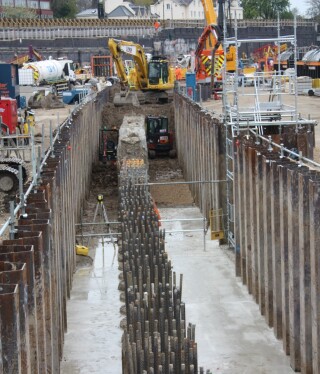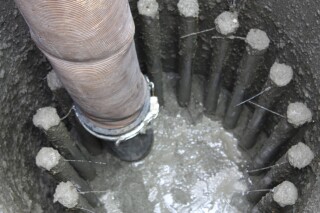The new zero trim pile technique uses a vacuum excavator to suck out excess concrete when still wet rather than wait for it to set and then cut it out.
The method is expected to save 60,000 working hours on a single site.
The technique has been developed by piling specialist Cementation Skanska, working for Skanska Costain Strabag joint venture (SCS JV) in London. The suction excavator was supplied by Hercules Site Services.
Lee Piper, a senior works superintendent with SCS, is credited with having identified the opportunity to test a new piling technique,. He worked with Cementation Skanska project director Deon Louw to develop the new approach.
The zero trim pile technique involves sucking out excess concrete while it is still wet, using a vacuum excavator. Traditionally in concrete bored piling, liquid concrete is overpoured and then the excess concrete has to be broken out after it has set. Removing the need to break out excess hard concrete makes the process safer and quicker.
Vacuum excavators are not new, but have not generally been used in this way before. Cirencester-based Hercules Site Services provided a machine for use on site in the Euston approaches. Extracted surplus concrete is retained and reused in construction elsewhere on site, with samples sent off for lab testing.
Lee Piper said: “I have worked in the construction sector for over 20 years, and the same piling techniques have been used throughout that time. Working with colleagues I saw an opportunity to try a new approach and was supported to do so by HS2.
“This technique could be transformational for the construction sector, reducing the health risk that results from breaking piles. The additional benefits of noise reduction, time and carbon savings mean the technique should be attractive for the whole sector to use going forward.”

Deon Louw said: ”This piling innovation has been developed as a result of a fantastically collaborative approach. This included trials with Hercules Site Services to perfect the vacuuming technique, together with extensive onsite testing to validate the integrity of the piles constructed using this new approach.
“We’ll be installing around 2,000 piles over the next three years in the Euston area. This zero trim innovation will bring amazing benefits in terms of reduced carbon, noise reduction and safer ways of working for our site teams. The potential health impacts associated with concrete breakdown are well known, so to be able to mitigate these risks from the outset is great for our people.
“Longer-term, we’ll be looking to see how we can use this innovation on future projects. It really does have the potential to be a game-changer for our industry.”
The zero trim technique is currently being used on HS2 worksites near Euston and is expected to be used on other sites across London where SCS JV is working. Cementation has a £93m contract for SCS JV. Discussions are taking place with other HS2 contractors to see how it can be used further across the route.
Malcolm Codling, client director for HS2, said: “At the site near Euston where this technique has already been put into practice, we estimate it will save 60,000 manhours, have a significant positive impact on the health and wellbeing of our staff, reduce noise for nearby residents as well as removing carbon from the construction process. Delivering this across the route could have a major impact on the HS2 project.”
Got a story? Email news@theconstructionindex.co.uk





